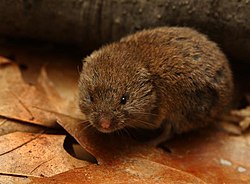| Pitymys | |
|---|---|
 | |
| Microtus pinetorum | |
| Scientific classification | |
| Kingdom: | Animalia |
| Phylum: | Chordata |
| Class: | Mammalia |
| Order: | Rodentia |
| Family: | Cricetidae |
| Subfamily: | Arvicolinae |
| Genus: | Microtus |
| Subgenus: | Pitymys McMurtrie, 1831 |
| Species | |
Microtus guatemalensis | |
Pitymys is a subgenus of voles in the genus Microtus . Species in this subgenus are:
- Guatemalan vole (Microtus guatemalensis)
- Tarabundí vole (Microtus oaxacensis)
- Woodland vole (Microtus pinetorum)
- Jalapan pine vole (Microtus quasiater)
Voles of this subgenus often show more adaptations for a fossorial mode of life.